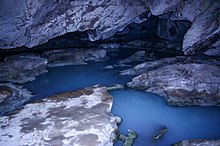You can help expand this article with text translated from the corresponding article in German. (March 2023) Click for important translation instructions.
|

Villa Luz Cave, Spanish name Cueva de Villa Luz (lit. Cave of the Lighted Town), also known as Cueva del Azufre and Cueva de las Sardinas, is a cave near Tapijulapa in the southern Mexican state of Tabasco. The springs within the cave are rich in hydrogen sulfide, a gas that is a potent respiratory toxicant and smells like rotten eggs. Within the water sulfide is oxidized to colloidal sulfur which gives the water a milky appearance, and creates sulfuric acid. The cave is essentially a maze about two kilometers in length and primarily etched out of limestone by the sulfuric acid in the water. Hydrogen sulfide is also used by chemoautotrophic bacteria, which form the base of the food web.
The cave is a popular tourist destination and visited by many, partly because it is easily accessible. It has been featured on the BBC's series Planet Earth, and Wonders of the Solar System.
See also
- Ophel biome [de], proposed worldwide biome supporting similar ecosystems
- Similar caves where life partly or fully depends on chemosynthesis: Movile Cave in Romania, the first one identified, Ein-Nur Cave and Ayalon Cave (Israel), Frasassi Caves (Italy), Melissotrypa Cave (Elassona municipality, Greece), Tashan Cave (Iran), caves in the Sharo-Argun Valley in the Caucasus Mountains, Lower Kane Cave, Cesspool Cave (Wyoming and Alleghany County, VA, USA).
References
- Sârbu, Şerban M. "The fascinating biology of stinky caves", - ARPHA Conference Abstracts, 25th International Conference on Subterranean Biology, Cluj-Napoca, 18-22 July 2022. Re-accessed 23 March 2024.
- Chiciudean, I., Russo, G., Bogdan, D.F. et al. "Competition-cooperation in the chemoautotrophic ecosystem of Movile Cave: first metagenomic approach on sediments." Environmental Microbiome 17, 44 (2022). Permanent doi
.org /10 .1186 /s40793-022-00438-w. Re-accessed 23 March 2024.
External links
- Hose L. D., Pisarowicz J. A. (1999) Cueva de Villa Luz, Tabasco, Mexico: reconnaissance study of an active sulfur spring cave and ecosystem. Journal of Cave and Karst Studies 61(1): 13–21.
- Cueva de Villa Luz Biological Investigations
- Cueva de Villa Luz at ShowCave
- National Geographic Magazine, Mexico's Poisonous Cave
- New Scientist Magazine, Acid House, 6 June 1998
- Research on cave mollies
- Research using the Cueva de Villa Luz
- New Scientist Magazine, Religious rite gives evolution a helping hand, 18 September 2010
17°26′37″N 92°45′53″W / 17.4437°N 92.7648°W / 17.4437; -92.7648
This article about a location in the Mexican state of Tabasco is a stub. You can help Misplaced Pages by expanding it. |